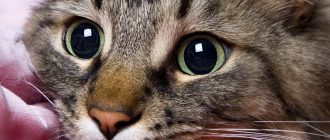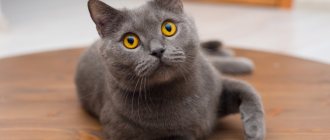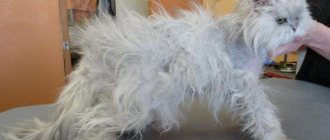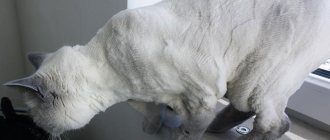11993Administration
1
It's a big decision to get a pet. Thus, we take responsibility for his well-being. But what if we encounter problems, for example, a cat’s fur is falling out in clumps, what should we do and how to help our pet?
What you are now faced with is not much like ordinary shedding, in which everything in the house is covered with an even layer of hair that has fallen from your cat. Now the wool is found in clumps. And you can often observe that this fur has come out along with part of the skin. Another unusual point is that the cat has bald patches here and there. And the skin turned red or scales or sores appeared on it.
© shutterstock
What are we dealing with? What kind of disease is this? Can we help our cat on our own? And should you seek help from a veterinarian?
Alopecia, or feline hair loss: what is it?
All cats shed twice a year, and this is the norm. How to distinguish: is it molting (the process when the fur is renewed) or pathology (baldness of the animal)? To do this, you need to know how the disease manifests itself, what its prerequisites are and in what cases the owner needs to sound the alarm.
Alopecia is the name given to abnormal hair loss in cats, as a result of which bald spots are formed on the animal's body - areas with absolutely no hair. The fur may fall out in clumps, forming bald areas on the animal's head, ears, and paws. Having noticed such areas, the owner should immediately take the pet to an appointment with a veterinarian. Baldness can be a signal of serious problems in the animal’s body.
But this should not be confused with hair loss, which normally occurs in all healthy felines. Cats lose their fur during:
- molting (a seasonal change of “coat” occurs twice a year; cats usually shed more than males);
- stress (the animal may shed some hair due to excitement);
- age-related changes (old animals lose hair and whiskers);
- frequent bathing (this is why it is recommended to bathe the animal only if necessary; twice a year is quite enough).
At the same time, the wool does not come out in clumps, without forming bald spots. But the disease has slightly different symptoms.
What it is?
The term “alopecia” in this case refers to hair loss, and it can be either local or massive, systemic. Simply put, this is baldness. In cats, this “disease” is quite common, and the causes of this disorder cannot be identified in all cases... However, such a pathology as psychogenic alopecia in cats has already been fully studied and confirmed. It occurs in the most “finely organized” animals.
Most often, chronic or very severe stress (even short-term) leads to this outcome. Cats are very sensitive animals to changes in their environment, so many things can cause it. Hair loss often begins suddenly, and within a couple of days your pet becomes a “Sphynx”, regardless of its original breed.
Here are the main reasons for what is happening:
- The appearance of a new cat in the house.
- Moving to another house or city.
- Large-scale renovation.
- The birth of a child, to whom all the attention of the cat’s owners is now directed.
- Death or divorce.
- “Chronic” chaos in the apartment.
- Boredom and a depressed, apathetic state.
- Restriction in movement (after injury, when a cast is applied).
- "Toilet problems."
Alopecia symptoms
You can recognize alopecia in a pet by the following signs:
- The fur falls out excessively, in clumps. Bald spots in cats appear mainly behind the ear, in the neck, back, and on the tail.
- The skin in these places may have its usual pink color or turn red, sores or scabs may appear there.
- Check your pet's reaction to touching the bald spot: perhaps the spot hurts or itches.
- Check if the animal has symmetrical bald spots.
If you notice these symptoms, you should urgently seek professional help from a veterinarian. Otherwise the disease will progress.
Causes of this disease
If an animal has bald spots on its body and head, this may be a sign of a food allergy. Allergies should be looked for in your pet's diet. They can be:
- Proteins of animal and plant origin;
- Various cereals;
- Meat – in particular lamb.
In addition, it may be an allergic reaction to flea bites, cigarette smoke or other odors (inhalation allergy).
The causes of baldness may lie in the psychological state of the pet, that is, hair may fall out due to stress. If the veterinarian diagnoses this reason, then the first thing the owner needs to do is find out what kind of stress or experience the pet has had recently, eliminate it, and only after that give sedatives, which only in this case will be effective. Symptoms of alopecia of a psychogenic nature are bald patches that are located on the thighs, abdomen or paws.
The causes belonging to the third group are infectious. If a cat's hair is falling out, the culprit may be scabies, lichen, fungus, or mites. If a cat has a bald spot behind its ear, it could be ringworm. There are several varieties: fungal (another name is ringworm; contagious to humans), psoriasis or eczema, viral.
Hair mites can also cause hair loss. They are very small and impossible to notice with the naked eye. Lice eaters do not live long, but they reproduce very quickly.
If your cat has bald spots on its neck, the cause may be dermatitis. It can be caused by various chemical and biological factors. Even treatment for parasites can cause hair loss.
Hair loss can be a consequence of seborrhea, a disease in which the functioning of the sebaceous glands is disrupted. This is usually indicated by baldness in a cat near the tail. That is why this disease is sometimes called “greasy tail”.
Another group of problems that cause baldness is disruption of the hormonal system:
- thyroid problems, manifested by both increased and insufficient levels of hormone production;
- diabetes;
- malfunctions of the adrenal glands, in particular their hyperfunction.
Other reasons include the presence of tumors in the animal, genetic predisposition and reactions to medications. Thus, a kitten’s bald spot may appear due to the fact that during pregnancy its mother did not receive various essential minerals and vitamins.
What are the causes of hair loss
The fact that a cat's neck hair is falling out is a sign of illness. What could it be? There are only 3 options:
- Skin problem,
- Internal diseases of organs,
- Stress.
Skin problems. Problems can also arise due to injection with a syringe. A lump forms under the cat's skin, causing hair to fall out. Contact dermatitis is another cause. This is a cat's reaction to allergens. But due to fleas and lichen, hair on the cat’s neck, back or tummy can also fall out greatly.
Organ diseases. Thyroid disease, blood problems, hormonal imbalances - all this becomes a serious problem due to which the pet suffers, and, as a result of the disease, hair loss on the neck and body.
© shutterstock
Stress. Any change in a cat's life leads to stress. For example, a bald spot may appear when moving to a country house or changing food. This also includes age-related changes, the birth of children, etc. But most often, hair falls out not only on the neck, but also behind the ear and near the eyes. In this case, you can often observe that the hair on the cat’s neck falls out in clumps.
Diagnosis of the disease
If a cat's hair falls out in clumps before bald spots form, it should definitely be seen by a specialist. Only a veterinarian can accurately determine the diagnosis. To determine the disease and prescribe the correct treatment, the doctor must:
- Find out how and when the disease manifested itself. The owner will have to tell in great detail the animal’s lifestyle, what the pet ate and drank, what it came into contact with, and whether it walked outside.
- Examine the patient.
- Examine hair roots under a microscope.
- You may need blood and hormone test data, and a scraping will be required.
- Sometimes an ultrasound or x-ray is done to confirm or rule out the presence of tumors.
Infectious and invasive diseases
If the reason lies in the invasion of a pathogenic fungus, the cat not only loses hair, but also crusts and scabs appear in large numbers, and the skin on the affected areas can become very flaky (pictured). Scabies is characterized by severe itching, redness, and even the appearance of foci of purulent inflammation.
With dermatitis, the main manifestation is severe and painful redness of the skin, local body temperature can rise significantly, the cat is constantly itching, sometimes it comes to wounds and ruptures of the skin. Various diseases of the endocrine system (feline endocrine alopecia) are also common, the clinical manifestations of which can be very diverse. To make it easier for you to determine the possible cause of your pet's baldness, we have prepared a table. It contains all the main pathologies accompanied by hair loss.
Treatment of hair loss in cats
Hair loss in cats is a serious but completely treatable disease. Treatment must be selected individually. What medications the doctor will prescribe depends on the causes of the disease. If bald spots on the ears or other places appear due to allergies, the animal must first be isolated from the allergen. The doctor also prescribes drugs that stimulate the immune system and antiallergic medications. If there is a food allergy, you should review the animal’s diet and switch it to hypoallergenic foods.
If the cause of an animal's hair loss is parasites, the pet is treated with gel and ointment that have antiparasitic properties. In such cases, it is also recommended to give the pet drugs that stimulate the immune system.
If the bald spots were caused by an abscess, the animal must undergo a course of treatment with antibiotics and antiseptics. If a cat has been diagnosed with endocrine problems, she is prescribed hormonal medications.
Preventive measures
To prevent ear baldness in cats and hair loss on other parts of the body, it is recommended to take preventive measures in advance. Namely:
- regularly independently examine the animal, take it for professional examinations, and, if necessary, for treatment at the veterinarian;
- vaccinate your pet on time;
- do not forget about proper hygienic care of the cat;
- Provide your pet with proper nutrition.
Bald spots in cats on the head, ears, belly or paws are a fairly common phenomenon. Why a cat has bald spots on its back or other parts of its body - only a doctor can say for sure after conducting the appropriate diagnosis. Depending on this, treatment is prescribed, which can consist only of diet, or contain a course of hormonal drugs or antibiotics. But it is highly not recommended to self-medicate your pet: you can only torture the animal with unnecessary drugs, and in the meantime the cat will lose most of its fur coat.
Bald spots at first glance seem harmless, although they spoil the aesthetic appearance of the animal. But it should be understood that they can be provoked by quite serious diseases that develop in a pet. Therefore, you should not hesitate to visit the doctor.
What to do with a “mentally unstable” cat?
Carefully evaluate your pet's living conditions, paying attention to the slightest changes that could cause baldness. Even a new diet or litter tray are “good” causes of alopecia in cats. If your work schedule has changed, as a result of which your cat spends days and nights in splendid isolation, sitting in the apartment, then you should not be surprised at the massive hair loss.
There is no need to immediately start feeding your pet sedatives. It may be possible to find an alternative solution. So, if the changes in the cat’s environment are not so critical and “monumental” (a new litter box, for example), you just need to be patient: soon everything will return to normal, and your pet’s fur will grow back.
But what if you simply have to rarely be at home? Then, no matter how strange it may seem, it’s worth getting a second cat. Yes, this is a very unique “treatment” at home: at first there will be fights and quarrels, which are also a strong stress factor, but at least the cat will not be alone all the time. If your pet is okay with dogs, we recommend getting a puppy. A cat (especially a young one) will have a playmate. Pets in such conditions quickly become best friends.
Unfortunately, “psychedelics” are not the main cause of baldness. Alopecia in a cat can be caused by more dangerous factors.










